HI6005: Content Theory of Motivation in Global Organizations Report
VerifiedAdded on 2022/12/30
|15
|4694
|43
Report
AI Summary
This report provides an overview of content theories of motivation, focusing on their application within organizations. It begins by differentiating between content and process theories, highlighting that content theories emphasize the needs and requirements of individuals. The report then delves into three key content theories: Maslow's Hierarchy of Needs, Herzberg's Two-Factor Theory, and McGregor's Theory X and Theory Y. Maslow's theory outlines a hierarchy of needs from basic physiological needs to self-actualization. Herzberg's theory distinguishes between hygiene factors (which prevent dissatisfaction) and motivator factors (which drive satisfaction). McGregor's theory presents two contrasting views of employee behavior. The report also addresses criticisms of Maslow's theory, including its rigid hierarchical structure and lack of consideration for cultural differences. The assignment is for the course HI6005 Management and Organisations in a Global Environment.

Running Head: Motivation Theory 0
Motivation Theory
Student Name
Date
Motivation Theory
Student Name
Date
Paraphrase This Document
Need a fresh take? Get an instant paraphrase of this document with our AI Paraphraser
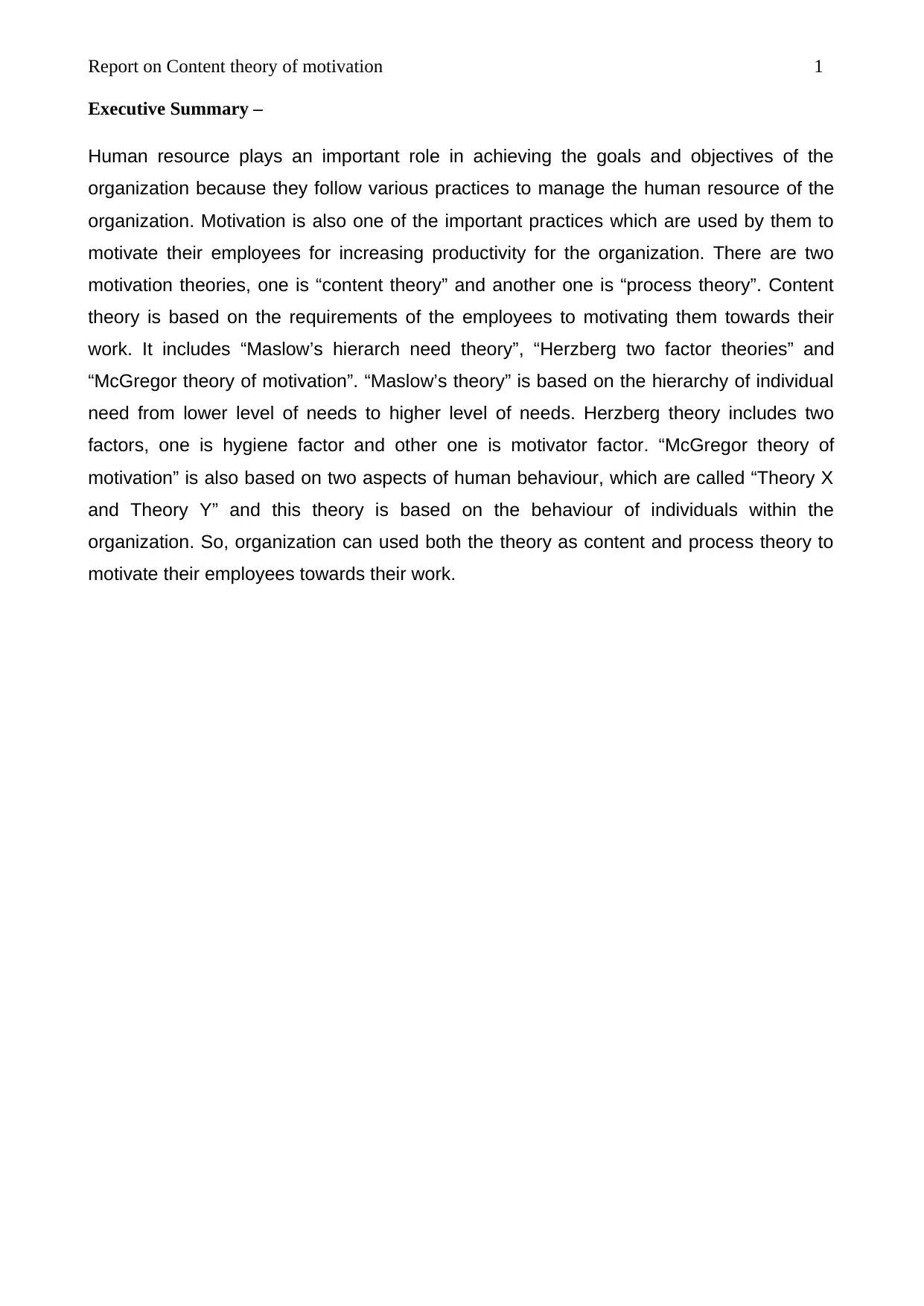
Report on Content theory of motivation 1
Executive Summary –
Human resource plays an important role in achieving the goals and objectives of the
organization because they follow various practices to manage the human resource of the
organization. Motivation is also one of the important practices which are used by them to
motivate their employees for increasing productivity for the organization. There are two
motivation theories, one is “content theory” and another one is “process theory”. Content
theory is based on the requirements of the employees to motivating them towards their
work. It includes “Maslow’s hierarch need theory”, “Herzberg two factor theories” and
“McGregor theory of motivation”. “Maslow’s theory” is based on the hierarchy of individual
need from lower level of needs to higher level of needs. Herzberg theory includes two
factors, one is hygiene factor and other one is motivator factor. “McGregor theory of
motivation” is also based on two aspects of human behaviour, which are called “Theory X
and Theory Y” and this theory is based on the behaviour of individuals within the
organization. So, organization can used both the theory as content and process theory to
motivate their employees towards their work.
Executive Summary –
Human resource plays an important role in achieving the goals and objectives of the
organization because they follow various practices to manage the human resource of the
organization. Motivation is also one of the important practices which are used by them to
motivate their employees for increasing productivity for the organization. There are two
motivation theories, one is “content theory” and another one is “process theory”. Content
theory is based on the requirements of the employees to motivating them towards their
work. It includes “Maslow’s hierarch need theory”, “Herzberg two factor theories” and
“McGregor theory of motivation”. “Maslow’s theory” is based on the hierarchy of individual
need from lower level of needs to higher level of needs. Herzberg theory includes two
factors, one is hygiene factor and other one is motivator factor. “McGregor theory of
motivation” is also based on two aspects of human behaviour, which are called “Theory X
and Theory Y” and this theory is based on the behaviour of individuals within the
organization. So, organization can used both the theory as content and process theory to
motivate their employees towards their work.
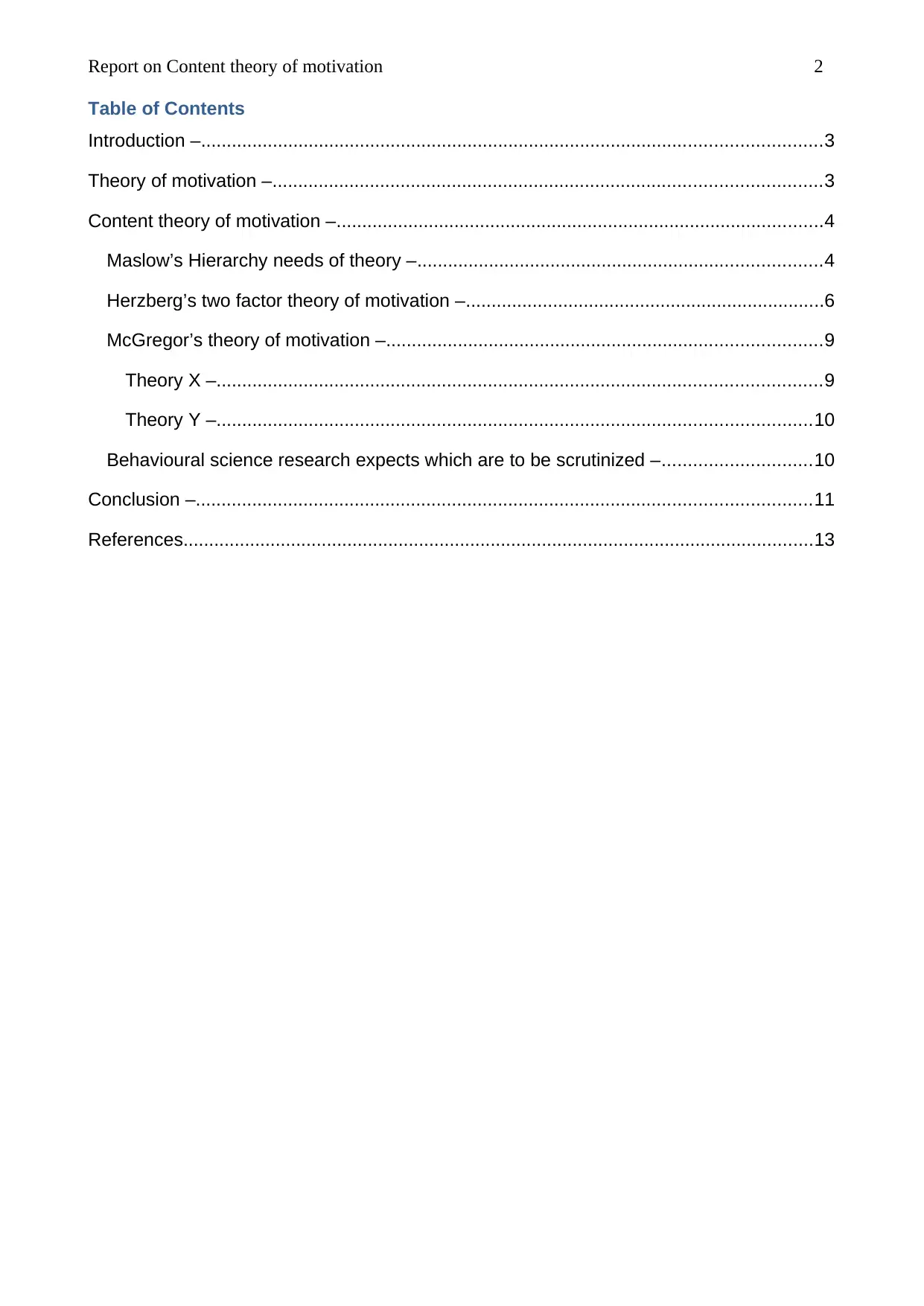
Report on Content theory of motivation 2
Table of Contents
Introduction –.........................................................................................................................3
Theory of motivation –...........................................................................................................3
Content theory of motivation –...............................................................................................4
Maslow’s Hierarchy needs of theory –...............................................................................4
Herzberg’s two factor theory of motivation –......................................................................6
McGregor’s theory of motivation –.....................................................................................9
Theory X –......................................................................................................................9
Theory Y –....................................................................................................................10
Behavioural science research expects which are to be scrutinized –.............................10
Conclusion –........................................................................................................................11
References...........................................................................................................................13
Table of Contents
Introduction –.........................................................................................................................3
Theory of motivation –...........................................................................................................3
Content theory of motivation –...............................................................................................4
Maslow’s Hierarchy needs of theory –...............................................................................4
Herzberg’s two factor theory of motivation –......................................................................6
McGregor’s theory of motivation –.....................................................................................9
Theory X –......................................................................................................................9
Theory Y –....................................................................................................................10
Behavioural science research expects which are to be scrutinized –.............................10
Conclusion –........................................................................................................................11
References...........................................................................................................................13
⊘ This is a preview!⊘
Do you want full access?
Subscribe today to unlock all pages.

Trusted by 1+ million students worldwide

Report on Content theory of motivation 3
Introduction –
Human resources are the most essential elements of every organization which are
managed by the HR manager of the organization. Human resource management follow
various practices for managing, motivating and increasing productivity of their employees
such as workforce planning, performance management, rewards system and training and
development, so by adopting the above practices they helps the organization in motivating
their workers (Hitt, Miller and Collela, 2009). Motivation is a crucial element for all
organization because it helps them in enhancing the performance of their employees,
productivity of the organization, improving efficiency of the organization and achieving the
objectives and overall organizational goals. So, it is essential that every employee has to
focus on their particular job responsibility with more energy and enthusiasm as same as
when they started their job in the organization (Peters, 2015). Motivation can be described
as those factors or forces within an employee which push them to satisfy the basic needs
or some specific needs. In other words, motivation is a complex process which helps the
organization in keeping their employees within the organization for longer period of time.
There are various importance of motivation for the organization such as it helps in
increasing productivity of the organization, ensures efficiency of the organization, ensuring
loyal employee within the organization which help in increasing overall productivity of the
organization and facilitates in providing direction to the employees of the organization.
There are two types of motivation, one is “intrinsic motivation” and other one is “extrinsic
motivation”. Intrinsic motivation refer as enjoyment for the employee during their task, so it
helps in increasing performance of their employees because if person enjoy their task then
they do not have burden by the outside party then they complete their task within the given
time period. Whereas, extrinsic motivation refer as when organization motivate to their
employees by rewards, money and other benefits (Petri and Govern, 2012).
Theory of motivation –
There are two theory of motivation, one is “content theory” and other one is “process
theory”. Content theory can be described as an earliest theory of motivation. This theory
focuses on the needs and requirements of the individuals within the organization. So,
Content theory explains the requirements and necessities of an individual which are
essential to motivate them. It includes various theory of motivation which was developed
by different theorists such as “Maslow’s hierarchy need of theory”, “Herzberg’s two factor
theory of motivation” and “McGregor’s theory of motivation”. Process theory can be
Introduction –
Human resources are the most essential elements of every organization which are
managed by the HR manager of the organization. Human resource management follow
various practices for managing, motivating and increasing productivity of their employees
such as workforce planning, performance management, rewards system and training and
development, so by adopting the above practices they helps the organization in motivating
their workers (Hitt, Miller and Collela, 2009). Motivation is a crucial element for all
organization because it helps them in enhancing the performance of their employees,
productivity of the organization, improving efficiency of the organization and achieving the
objectives and overall organizational goals. So, it is essential that every employee has to
focus on their particular job responsibility with more energy and enthusiasm as same as
when they started their job in the organization (Peters, 2015). Motivation can be described
as those factors or forces within an employee which push them to satisfy the basic needs
or some specific needs. In other words, motivation is a complex process which helps the
organization in keeping their employees within the organization for longer period of time.
There are various importance of motivation for the organization such as it helps in
increasing productivity of the organization, ensures efficiency of the organization, ensuring
loyal employee within the organization which help in increasing overall productivity of the
organization and facilitates in providing direction to the employees of the organization.
There are two types of motivation, one is “intrinsic motivation” and other one is “extrinsic
motivation”. Intrinsic motivation refer as enjoyment for the employee during their task, so it
helps in increasing performance of their employees because if person enjoy their task then
they do not have burden by the outside party then they complete their task within the given
time period. Whereas, extrinsic motivation refer as when organization motivate to their
employees by rewards, money and other benefits (Petri and Govern, 2012).
Theory of motivation –
There are two theory of motivation, one is “content theory” and other one is “process
theory”. Content theory can be described as an earliest theory of motivation. This theory
focuses on the needs and requirements of the individuals within the organization. So,
Content theory explains the requirements and necessities of an individual which are
essential to motivate them. It includes various theory of motivation which was developed
by different theorists such as “Maslow’s hierarchy need of theory”, “Herzberg’s two factor
theory of motivation” and “McGregor’s theory of motivation”. Process theory can be
Paraphrase This Document
Need a fresh take? Get an instant paraphrase of this document with our AI Paraphraser
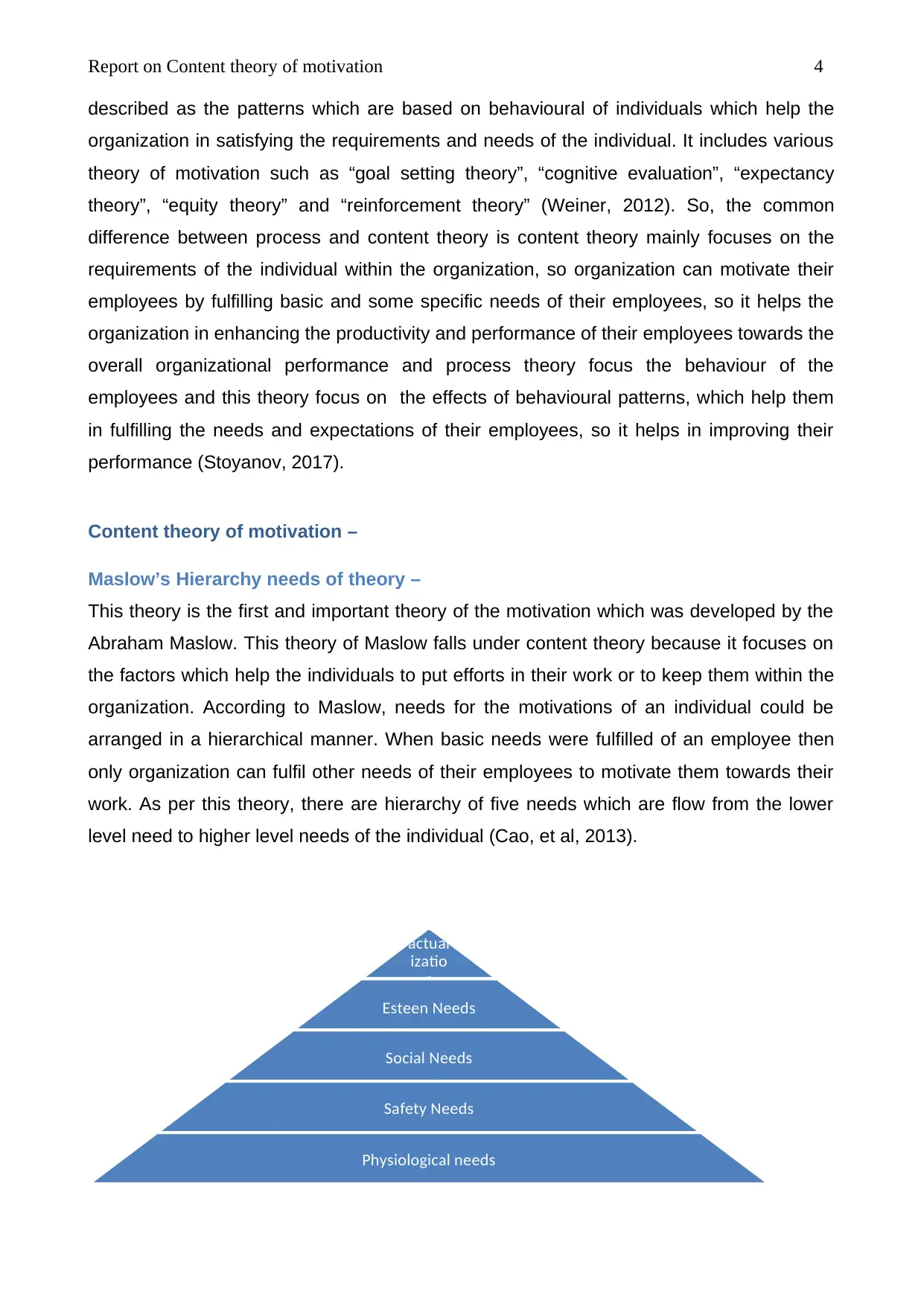
Report on Content theory of motivation 4
described as the patterns which are based on behavioural of individuals which help the
organization in satisfying the requirements and needs of the individual. It includes various
theory of motivation such as “goal setting theory”, “cognitive evaluation”, “expectancy
theory”, “equity theory” and “reinforcement theory” (Weiner, 2012). So, the common
difference between process and content theory is content theory mainly focuses on the
requirements of the individual within the organization, so organization can motivate their
employees by fulfilling basic and some specific needs of their employees, so it helps the
organization in enhancing the productivity and performance of their employees towards the
overall organizational performance and process theory focus the behaviour of the
employees and this theory focus on the effects of behavioural patterns, which help them
in fulfilling the needs and expectations of their employees, so it helps in improving their
performance (Stoyanov, 2017).
Content theory of motivation –
Maslow’s Hierarchy needs of theory –
This theory is the first and important theory of the motivation which was developed by the
Abraham Maslow. This theory of Maslow falls under content theory because it focuses on
the factors which help the individuals to put efforts in their work or to keep them within the
organization. According to Maslow, needs for the motivations of an individual could be
arranged in a hierarchical manner. When basic needs were fulfilled of an employee then
only organization can fulfil other needs of their employees to motivate them towards their
work. As per this theory, there are hierarchy of five needs which are flow from the lower
level need to higher level needs of the individual (Cao, et al, 2013).
Self -
actual
izatio
n
needs
Esteen Needs
Social Needs
Safety Needs
Physiological needs
described as the patterns which are based on behavioural of individuals which help the
organization in satisfying the requirements and needs of the individual. It includes various
theory of motivation such as “goal setting theory”, “cognitive evaluation”, “expectancy
theory”, “equity theory” and “reinforcement theory” (Weiner, 2012). So, the common
difference between process and content theory is content theory mainly focuses on the
requirements of the individual within the organization, so organization can motivate their
employees by fulfilling basic and some specific needs of their employees, so it helps the
organization in enhancing the productivity and performance of their employees towards the
overall organizational performance and process theory focus the behaviour of the
employees and this theory focus on the effects of behavioural patterns, which help them
in fulfilling the needs and expectations of their employees, so it helps in improving their
performance (Stoyanov, 2017).
Content theory of motivation –
Maslow’s Hierarchy needs of theory –
This theory is the first and important theory of the motivation which was developed by the
Abraham Maslow. This theory of Maslow falls under content theory because it focuses on
the factors which help the individuals to put efforts in their work or to keep them within the
organization. According to Maslow, needs for the motivations of an individual could be
arranged in a hierarchical manner. When basic needs were fulfilled of an employee then
only organization can fulfil other needs of their employees to motivate them towards their
work. As per this theory, there are hierarchy of five needs which are flow from the lower
level need to higher level needs of the individual (Cao, et al, 2013).
Self -
actual
izatio
n
needs
Esteen Needs
Social Needs
Safety Needs
Physiological needs
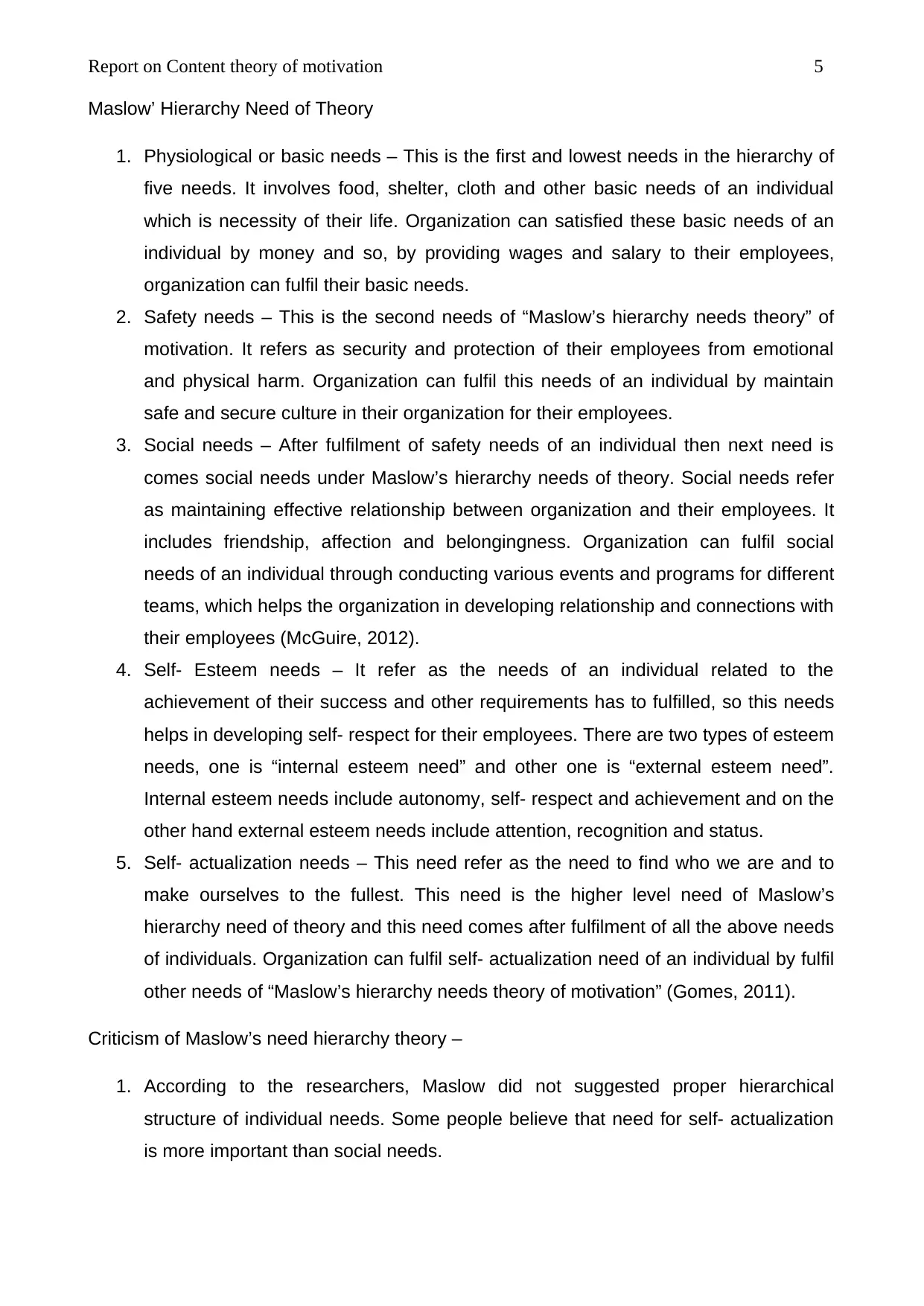
Report on Content theory of motivation 5
Maslow’ Hierarchy Need of Theory
1. Physiological or basic needs – This is the first and lowest needs in the hierarchy of
five needs. It involves food, shelter, cloth and other basic needs of an individual
which is necessity of their life. Organization can satisfied these basic needs of an
individual by money and so, by providing wages and salary to their employees,
organization can fulfil their basic needs.
2. Safety needs – This is the second needs of “Maslow’s hierarchy needs theory” of
motivation. It refers as security and protection of their employees from emotional
and physical harm. Organization can fulfil this needs of an individual by maintain
safe and secure culture in their organization for their employees.
3. Social needs – After fulfilment of safety needs of an individual then next need is
comes social needs under Maslow’s hierarchy needs of theory. Social needs refer
as maintaining effective relationship between organization and their employees. It
includes friendship, affection and belongingness. Organization can fulfil social
needs of an individual through conducting various events and programs for different
teams, which helps the organization in developing relationship and connections with
their employees (McGuire, 2012).
4. Self- Esteem needs – It refer as the needs of an individual related to the
achievement of their success and other requirements has to fulfilled, so this needs
helps in developing self- respect for their employees. There are two types of esteem
needs, one is “internal esteem need” and other one is “external esteem need”.
Internal esteem needs include autonomy, self- respect and achievement and on the
other hand external esteem needs include attention, recognition and status.
5. Self- actualization needs – This need refer as the need to find who we are and to
make ourselves to the fullest. This need is the higher level need of Maslow’s
hierarchy need of theory and this need comes after fulfilment of all the above needs
of individuals. Organization can fulfil self- actualization need of an individual by fulfil
other needs of “Maslow’s hierarchy needs theory of motivation” (Gomes, 2011).
Criticism of Maslow’s need hierarchy theory –
1. According to the researchers, Maslow did not suggested proper hierarchical
structure of individual needs. Some people believe that need for self- actualization
is more important than social needs.
Maslow’ Hierarchy Need of Theory
1. Physiological or basic needs – This is the first and lowest needs in the hierarchy of
five needs. It involves food, shelter, cloth and other basic needs of an individual
which is necessity of their life. Organization can satisfied these basic needs of an
individual by money and so, by providing wages and salary to their employees,
organization can fulfil their basic needs.
2. Safety needs – This is the second needs of “Maslow’s hierarchy needs theory” of
motivation. It refers as security and protection of their employees from emotional
and physical harm. Organization can fulfil this needs of an individual by maintain
safe and secure culture in their organization for their employees.
3. Social needs – After fulfilment of safety needs of an individual then next need is
comes social needs under Maslow’s hierarchy needs of theory. Social needs refer
as maintaining effective relationship between organization and their employees. It
includes friendship, affection and belongingness. Organization can fulfil social
needs of an individual through conducting various events and programs for different
teams, which helps the organization in developing relationship and connections with
their employees (McGuire, 2012).
4. Self- Esteem needs – It refer as the needs of an individual related to the
achievement of their success and other requirements has to fulfilled, so this needs
helps in developing self- respect for their employees. There are two types of esteem
needs, one is “internal esteem need” and other one is “external esteem need”.
Internal esteem needs include autonomy, self- respect and achievement and on the
other hand external esteem needs include attention, recognition and status.
5. Self- actualization needs – This need refer as the need to find who we are and to
make ourselves to the fullest. This need is the higher level need of Maslow’s
hierarchy need of theory and this need comes after fulfilment of all the above needs
of individuals. Organization can fulfil self- actualization need of an individual by fulfil
other needs of “Maslow’s hierarchy needs theory of motivation” (Gomes, 2011).
Criticism of Maslow’s need hierarchy theory –
1. According to the researchers, Maslow did not suggested proper hierarchical
structure of individual needs. Some people believe that need for self- actualization
is more important than social needs.
⊘ This is a preview!⊘
Do you want full access?
Subscribe today to unlock all pages.

Trusted by 1+ million students worldwide

Report on Content theory of motivation 6
2. This theory does not focus on the behavioural of an individual for satisfying their
needs and requirements.
3. There is no direct and cause and effect relationship between need and behaviour of
an individual for fulfilling their needs, which is used by the company to encourage
their staffs for improving the performance and productivity of their employees
towards the organization, but as per this theory these is no cause and effect
relationship because one need may cause different behaviour in different
employees (Kaur, 2013).
4. Organization can also fulfil more than one level of needs of their employees at the
same time.
5. Researcher may find difficulties while testing “Maslow’s hierarchy need of theory”.
6. This theory fails to consider the different cultures while setting the hierarchy of five
needs and this theory also assumes that all employees are uniform which is not
possible as every employee have different behaviour and culture (Alajmi and
Alasousi, 2019). Another crucial theory relating to culture is one given by Gerard
Hendrik Hofstede, also known as Hofstede's cultural dimensions theory. These
dimensions help in understanding what motivates an employee to act in a particular
manner, based on their cultural background.
Herzberg’s two factor theory of motivation –
This is another theory of motivation, which was founded by Frederick Herzberg in 1959.
This theory falls under content theory and it is also called as two factor theory. Herzberg
set this theory on the basis of two factors as he believed that job satisfaction of an
individual is depend on these two factors, one is factors for satisfaction or motivators
factors of the employees and other one is factors for dissatisfaction of the employees or
hygiene factors for the employees within the organization (Law, 2016).
2. This theory does not focus on the behavioural of an individual for satisfying their
needs and requirements.
3. There is no direct and cause and effect relationship between need and behaviour of
an individual for fulfilling their needs, which is used by the company to encourage
their staffs for improving the performance and productivity of their employees
towards the organization, but as per this theory these is no cause and effect
relationship because one need may cause different behaviour in different
employees (Kaur, 2013).
4. Organization can also fulfil more than one level of needs of their employees at the
same time.
5. Researcher may find difficulties while testing “Maslow’s hierarchy need of theory”.
6. This theory fails to consider the different cultures while setting the hierarchy of five
needs and this theory also assumes that all employees are uniform which is not
possible as every employee have different behaviour and culture (Alajmi and
Alasousi, 2019). Another crucial theory relating to culture is one given by Gerard
Hendrik Hofstede, also known as Hofstede's cultural dimensions theory. These
dimensions help in understanding what motivates an employee to act in a particular
manner, based on their cultural background.
Herzberg’s two factor theory of motivation –
This is another theory of motivation, which was founded by Frederick Herzberg in 1959.
This theory falls under content theory and it is also called as two factor theory. Herzberg
set this theory on the basis of two factors as he believed that job satisfaction of an
individual is depend on these two factors, one is factors for satisfaction or motivators
factors of the employees and other one is factors for dissatisfaction of the employees or
hygiene factors for the employees within the organization (Law, 2016).
Paraphrase This Document
Need a fresh take? Get an instant paraphrase of this document with our AI Paraphraser
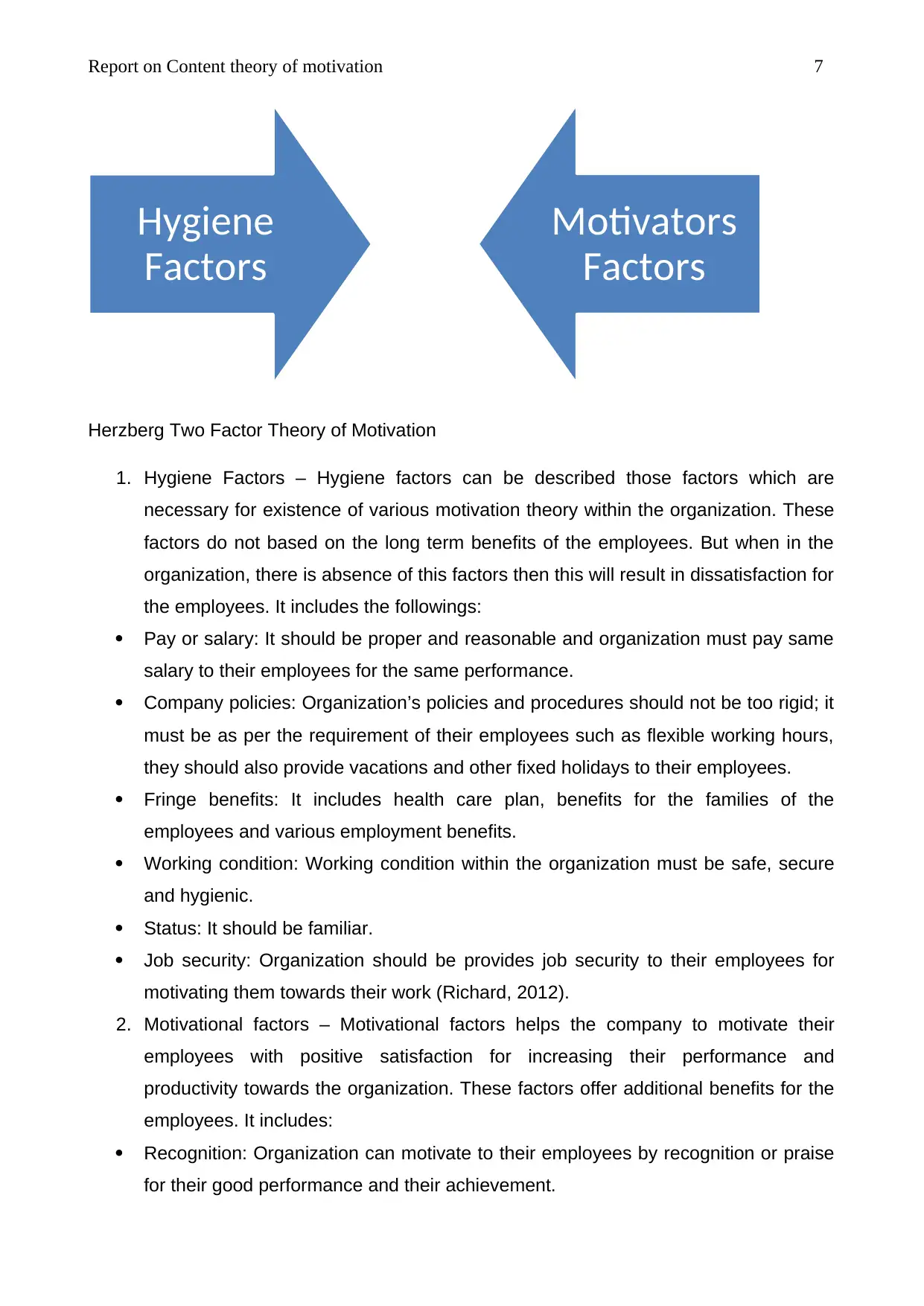
Report on Content theory of motivation 7
Herzberg Two Factor Theory of Motivation
1. Hygiene Factors – Hygiene factors can be described those factors which are
necessary for existence of various motivation theory within the organization. These
factors do not based on the long term benefits of the employees. But when in the
organization, there is absence of this factors then this will result in dissatisfaction for
the employees. It includes the followings:
Pay or salary: It should be proper and reasonable and organization must pay same
salary to their employees for the same performance.
Company policies: Organization’s policies and procedures should not be too rigid; it
must be as per the requirement of their employees such as flexible working hours,
they should also provide vacations and other fixed holidays to their employees.
Fringe benefits: It includes health care plan, benefits for the families of the
employees and various employment benefits.
Working condition: Working condition within the organization must be safe, secure
and hygienic.
Status: It should be familiar.
Job security: Organization should be provides job security to their employees for
motivating them towards their work (Richard, 2012).
2. Motivational factors – Motivational factors helps the company to motivate their
employees with positive satisfaction for increasing their performance and
productivity towards the organization. These factors offer additional benefits for the
employees. It includes:
Recognition: Organization can motivate to their employees by recognition or praise
for their good performance and their achievement.
Hygiene
Factors
Motivators
Factors
Herzberg Two Factor Theory of Motivation
1. Hygiene Factors – Hygiene factors can be described those factors which are
necessary for existence of various motivation theory within the organization. These
factors do not based on the long term benefits of the employees. But when in the
organization, there is absence of this factors then this will result in dissatisfaction for
the employees. It includes the followings:
Pay or salary: It should be proper and reasonable and organization must pay same
salary to their employees for the same performance.
Company policies: Organization’s policies and procedures should not be too rigid; it
must be as per the requirement of their employees such as flexible working hours,
they should also provide vacations and other fixed holidays to their employees.
Fringe benefits: It includes health care plan, benefits for the families of the
employees and various employment benefits.
Working condition: Working condition within the organization must be safe, secure
and hygienic.
Status: It should be familiar.
Job security: Organization should be provides job security to their employees for
motivating them towards their work (Richard, 2012).
2. Motivational factors – Motivational factors helps the company to motivate their
employees with positive satisfaction for increasing their performance and
productivity towards the organization. These factors offer additional benefits for the
employees. It includes:
Recognition: Organization can motivate to their employees by recognition or praise
for their good performance and their achievement.
Hygiene
Factors
Motivators
Factors
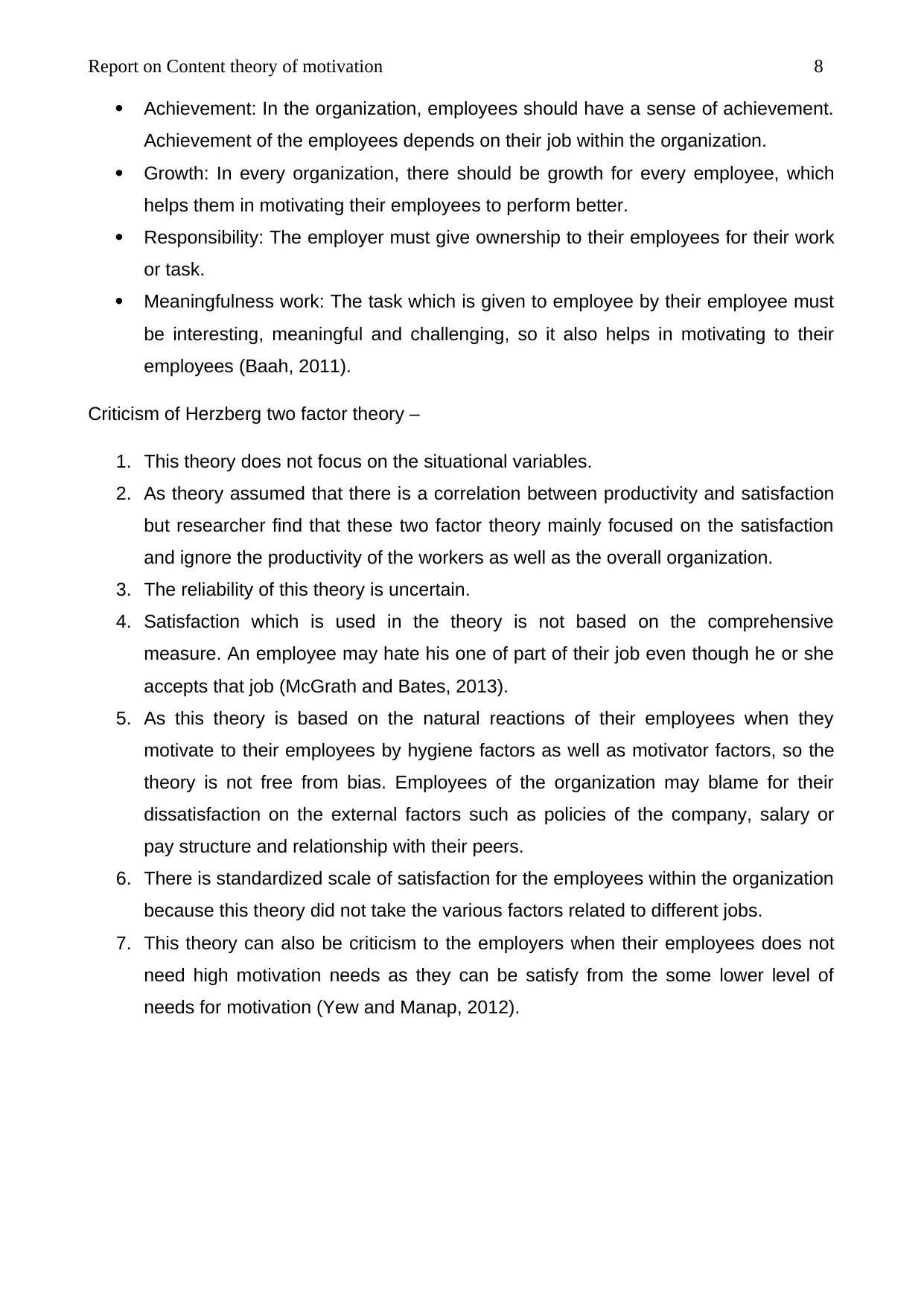
Report on Content theory of motivation 8
Achievement: In the organization, employees should have a sense of achievement.
Achievement of the employees depends on their job within the organization.
Growth: In every organization, there should be growth for every employee, which
helps them in motivating their employees to perform better.
Responsibility: The employer must give ownership to their employees for their work
or task.
Meaningfulness work: The task which is given to employee by their employee must
be interesting, meaningful and challenging, so it also helps in motivating to their
employees (Baah, 2011).
Criticism of Herzberg two factor theory –
1. This theory does not focus on the situational variables.
2. As theory assumed that there is a correlation between productivity and satisfaction
but researcher find that these two factor theory mainly focused on the satisfaction
and ignore the productivity of the workers as well as the overall organization.
3. The reliability of this theory is uncertain.
4. Satisfaction which is used in the theory is not based on the comprehensive
measure. An employee may hate his one of part of their job even though he or she
accepts that job (McGrath and Bates, 2013).
5. As this theory is based on the natural reactions of their employees when they
motivate to their employees by hygiene factors as well as motivator factors, so the
theory is not free from bias. Employees of the organization may blame for their
dissatisfaction on the external factors such as policies of the company, salary or
pay structure and relationship with their peers.
6. There is standardized scale of satisfaction for the employees within the organization
because this theory did not take the various factors related to different jobs.
7. This theory can also be criticism to the employers when their employees does not
need high motivation needs as they can be satisfy from the some lower level of
needs for motivation (Yew and Manap, 2012).
Achievement: In the organization, employees should have a sense of achievement.
Achievement of the employees depends on their job within the organization.
Growth: In every organization, there should be growth for every employee, which
helps them in motivating their employees to perform better.
Responsibility: The employer must give ownership to their employees for their work
or task.
Meaningfulness work: The task which is given to employee by their employee must
be interesting, meaningful and challenging, so it also helps in motivating to their
employees (Baah, 2011).
Criticism of Herzberg two factor theory –
1. This theory does not focus on the situational variables.
2. As theory assumed that there is a correlation between productivity and satisfaction
but researcher find that these two factor theory mainly focused on the satisfaction
and ignore the productivity of the workers as well as the overall organization.
3. The reliability of this theory is uncertain.
4. Satisfaction which is used in the theory is not based on the comprehensive
measure. An employee may hate his one of part of their job even though he or she
accepts that job (McGrath and Bates, 2013).
5. As this theory is based on the natural reactions of their employees when they
motivate to their employees by hygiene factors as well as motivator factors, so the
theory is not free from bias. Employees of the organization may blame for their
dissatisfaction on the external factors such as policies of the company, salary or
pay structure and relationship with their peers.
6. There is standardized scale of satisfaction for the employees within the organization
because this theory did not take the various factors related to different jobs.
7. This theory can also be criticism to the employers when their employees does not
need high motivation needs as they can be satisfy from the some lower level of
needs for motivation (Yew and Manap, 2012).
⊘ This is a preview!⊘
Do you want full access?
Subscribe today to unlock all pages.

Trusted by 1+ million students worldwide
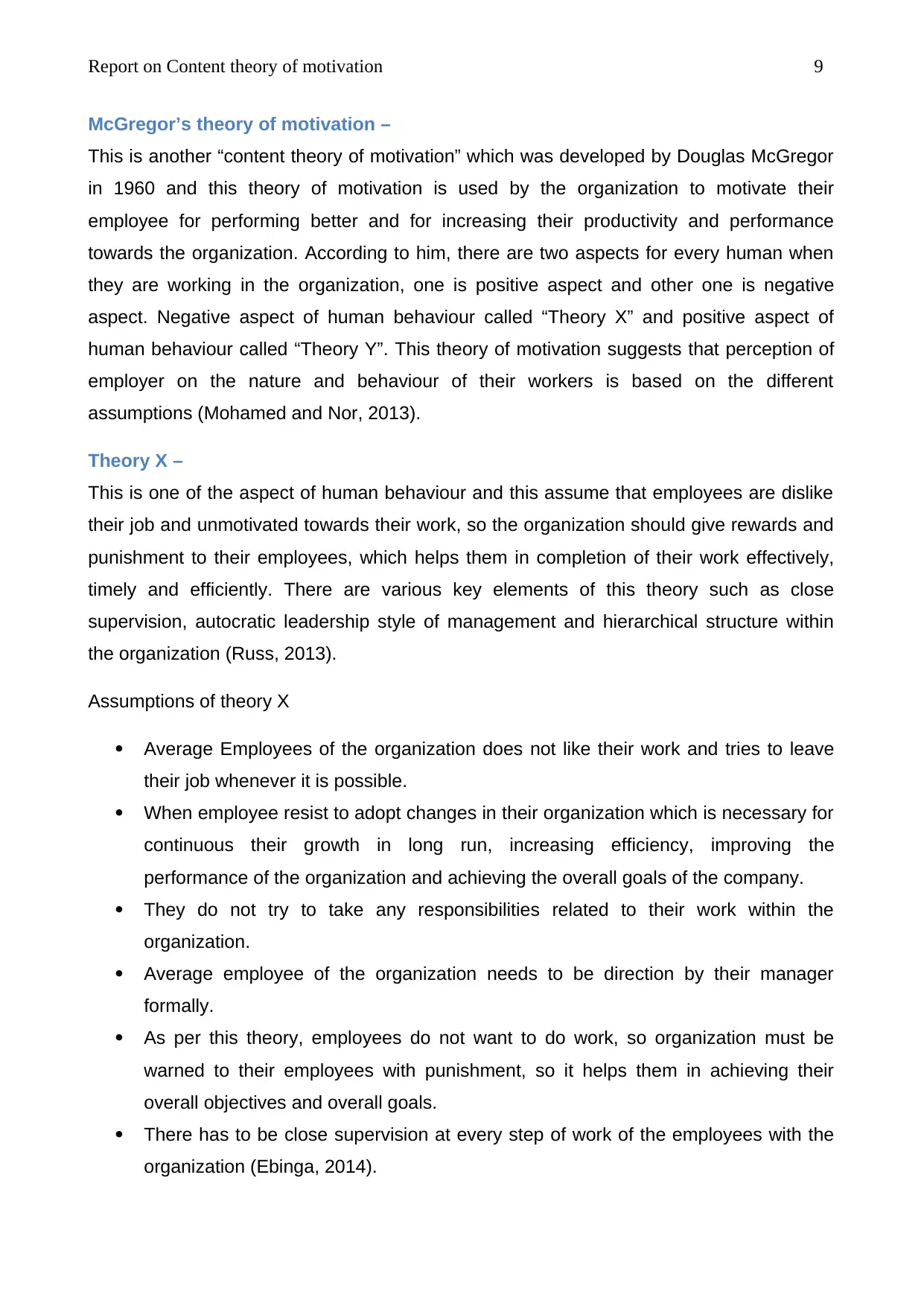
Report on Content theory of motivation 9
McGregor’s theory of motivation –
This is another “content theory of motivation” which was developed by Douglas McGregor
in 1960 and this theory of motivation is used by the organization to motivate their
employee for performing better and for increasing their productivity and performance
towards the organization. According to him, there are two aspects for every human when
they are working in the organization, one is positive aspect and other one is negative
aspect. Negative aspect of human behaviour called “Theory X” and positive aspect of
human behaviour called “Theory Y”. This theory of motivation suggests that perception of
employer on the nature and behaviour of their workers is based on the different
assumptions (Mohamed and Nor, 2013).
Theory X –
This is one of the aspect of human behaviour and this assume that employees are dislike
their job and unmotivated towards their work, so the organization should give rewards and
punishment to their employees, which helps them in completion of their work effectively,
timely and efficiently. There are various key elements of this theory such as close
supervision, autocratic leadership style of management and hierarchical structure within
the organization (Russ, 2013).
Assumptions of theory X
Average Employees of the organization does not like their work and tries to leave
their job whenever it is possible.
When employee resist to adopt changes in their organization which is necessary for
continuous their growth in long run, increasing efficiency, improving the
performance of the organization and achieving the overall goals of the company.
They do not try to take any responsibilities related to their work within the
organization.
Average employee of the organization needs to be direction by their manager
formally.
As per this theory, employees do not want to do work, so organization must be
warned to their employees with punishment, so it helps them in achieving their
overall objectives and overall goals.
There has to be close supervision at every step of work of the employees with the
organization (Ebinga, 2014).
McGregor’s theory of motivation –
This is another “content theory of motivation” which was developed by Douglas McGregor
in 1960 and this theory of motivation is used by the organization to motivate their
employee for performing better and for increasing their productivity and performance
towards the organization. According to him, there are two aspects for every human when
they are working in the organization, one is positive aspect and other one is negative
aspect. Negative aspect of human behaviour called “Theory X” and positive aspect of
human behaviour called “Theory Y”. This theory of motivation suggests that perception of
employer on the nature and behaviour of their workers is based on the different
assumptions (Mohamed and Nor, 2013).
Theory X –
This is one of the aspect of human behaviour and this assume that employees are dislike
their job and unmotivated towards their work, so the organization should give rewards and
punishment to their employees, which helps them in completion of their work effectively,
timely and efficiently. There are various key elements of this theory such as close
supervision, autocratic leadership style of management and hierarchical structure within
the organization (Russ, 2013).
Assumptions of theory X
Average Employees of the organization does not like their work and tries to leave
their job whenever it is possible.
When employee resist to adopt changes in their organization which is necessary for
continuous their growth in long run, increasing efficiency, improving the
performance of the organization and achieving the overall goals of the company.
They do not try to take any responsibilities related to their work within the
organization.
Average employee of the organization needs to be direction by their manager
formally.
As per this theory, employees do not want to do work, so organization must be
warned to their employees with punishment, so it helps them in achieving their
overall objectives and overall goals.
There has to be close supervision at every step of work of the employees with the
organization (Ebinga, 2014).
Paraphrase This Document
Need a fresh take? Get an instant paraphrase of this document with our AI Paraphraser
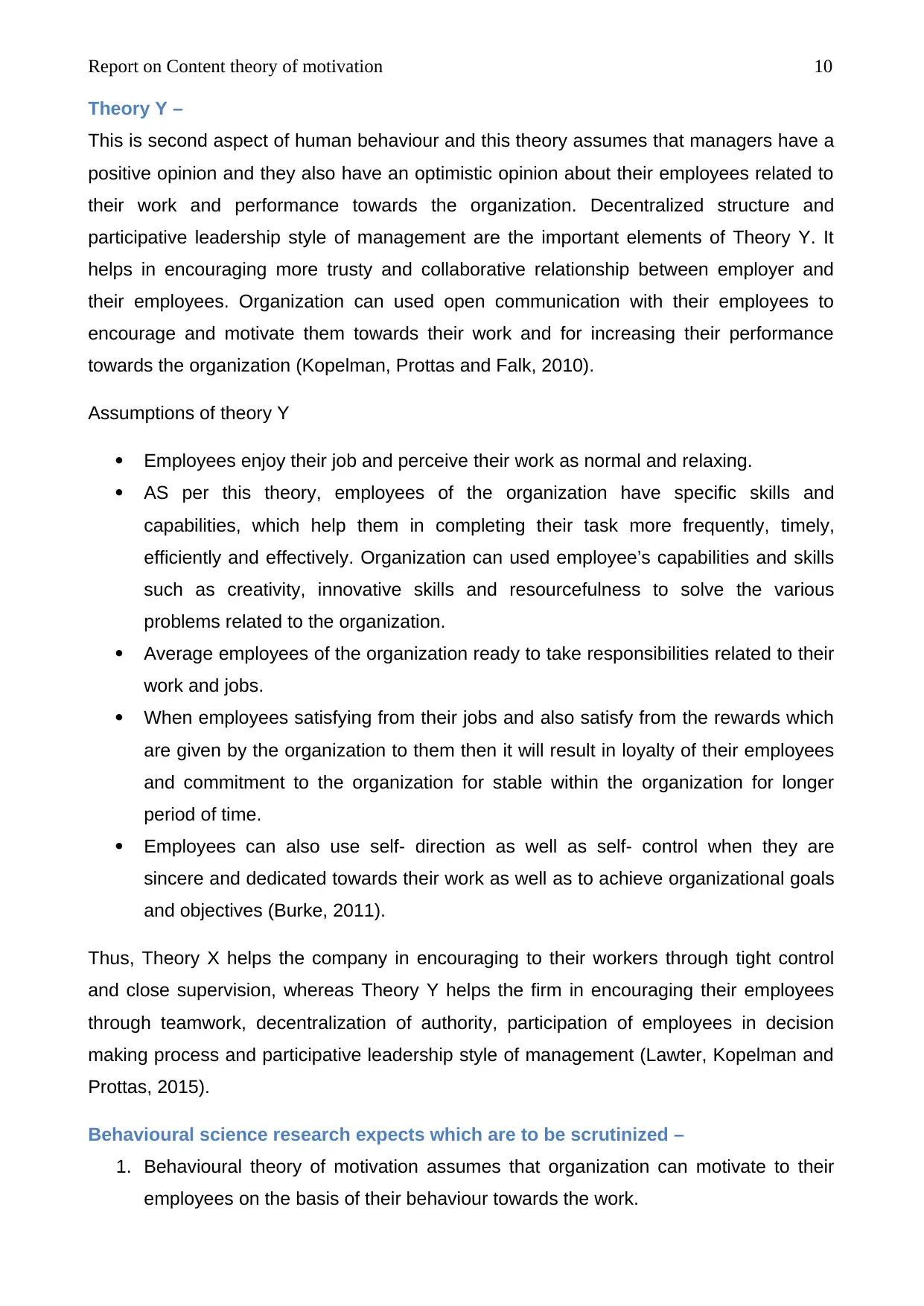
Report on Content theory of motivation 10
Theory Y –
This is second aspect of human behaviour and this theory assumes that managers have a
positive opinion and they also have an optimistic opinion about their employees related to
their work and performance towards the organization. Decentralized structure and
participative leadership style of management are the important elements of Theory Y. It
helps in encouraging more trusty and collaborative relationship between employer and
their employees. Organization can used open communication with their employees to
encourage and motivate them towards their work and for increasing their performance
towards the organization (Kopelman, Prottas and Falk, 2010).
Assumptions of theory Y
Employees enjoy their job and perceive their work as normal and relaxing.
AS per this theory, employees of the organization have specific skills and
capabilities, which help them in completing their task more frequently, timely,
efficiently and effectively. Organization can used employee’s capabilities and skills
such as creativity, innovative skills and resourcefulness to solve the various
problems related to the organization.
Average employees of the organization ready to take responsibilities related to their
work and jobs.
When employees satisfying from their jobs and also satisfy from the rewards which
are given by the organization to them then it will result in loyalty of their employees
and commitment to the organization for stable within the organization for longer
period of time.
Employees can also use self- direction as well as self- control when they are
sincere and dedicated towards their work as well as to achieve organizational goals
and objectives (Burke, 2011).
Thus, Theory X helps the company in encouraging to their workers through tight control
and close supervision, whereas Theory Y helps the firm in encouraging their employees
through teamwork, decentralization of authority, participation of employees in decision
making process and participative leadership style of management (Lawter, Kopelman and
Prottas, 2015).
Behavioural science research expects which are to be scrutinized –
1. Behavioural theory of motivation assumes that organization can motivate to their
employees on the basis of their behaviour towards the work.
Theory Y –
This is second aspect of human behaviour and this theory assumes that managers have a
positive opinion and they also have an optimistic opinion about their employees related to
their work and performance towards the organization. Decentralized structure and
participative leadership style of management are the important elements of Theory Y. It
helps in encouraging more trusty and collaborative relationship between employer and
their employees. Organization can used open communication with their employees to
encourage and motivate them towards their work and for increasing their performance
towards the organization (Kopelman, Prottas and Falk, 2010).
Assumptions of theory Y
Employees enjoy their job and perceive their work as normal and relaxing.
AS per this theory, employees of the organization have specific skills and
capabilities, which help them in completing their task more frequently, timely,
efficiently and effectively. Organization can used employee’s capabilities and skills
such as creativity, innovative skills and resourcefulness to solve the various
problems related to the organization.
Average employees of the organization ready to take responsibilities related to their
work and jobs.
When employees satisfying from their jobs and also satisfy from the rewards which
are given by the organization to them then it will result in loyalty of their employees
and commitment to the organization for stable within the organization for longer
period of time.
Employees can also use self- direction as well as self- control when they are
sincere and dedicated towards their work as well as to achieve organizational goals
and objectives (Burke, 2011).
Thus, Theory X helps the company in encouraging to their workers through tight control
and close supervision, whereas Theory Y helps the firm in encouraging their employees
through teamwork, decentralization of authority, participation of employees in decision
making process and participative leadership style of management (Lawter, Kopelman and
Prottas, 2015).
Behavioural science research expects which are to be scrutinized –
1. Behavioural theory of motivation assumes that organization can motivate to their
employees on the basis of their behaviour towards the work.
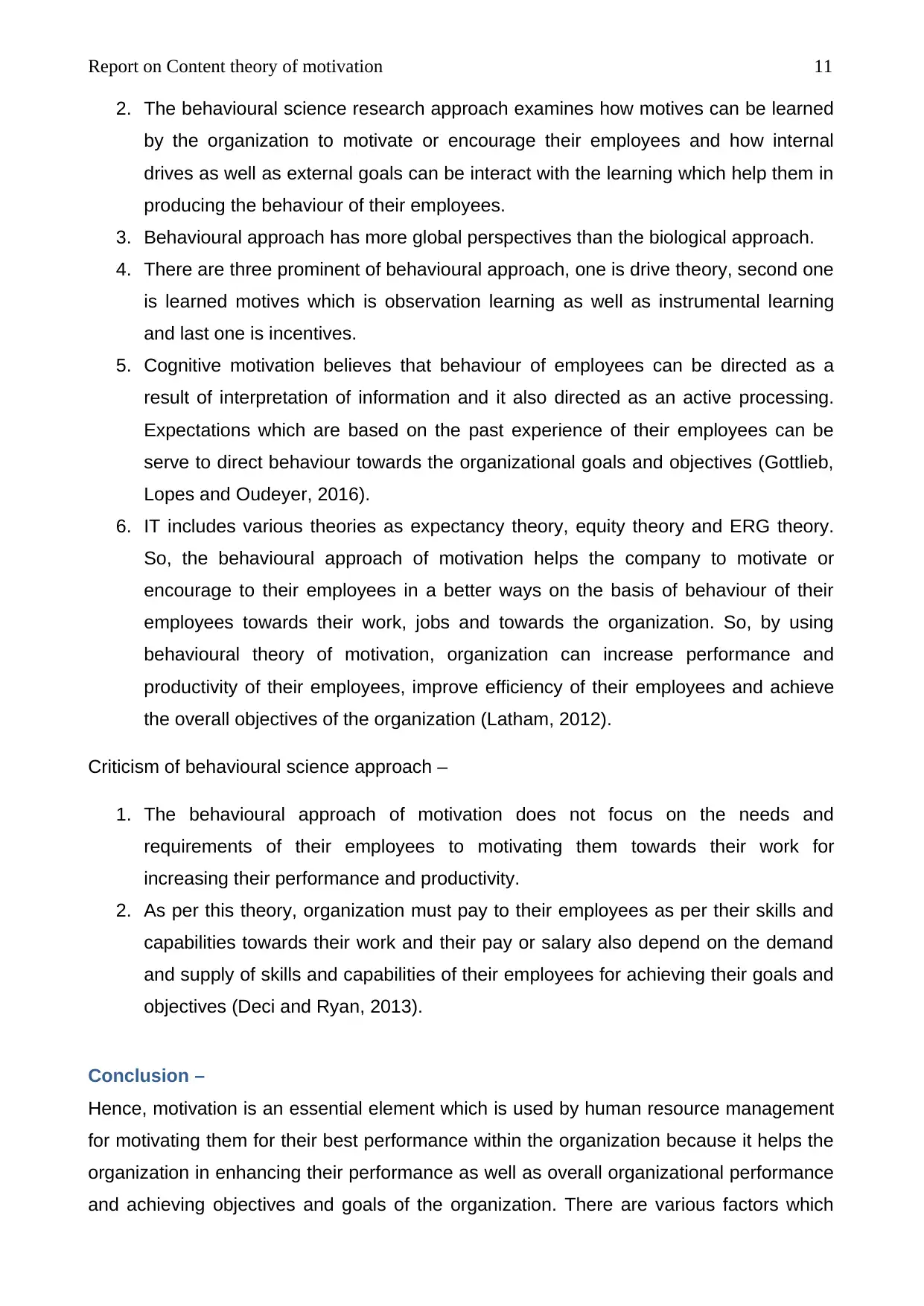
Report on Content theory of motivation 11
2. The behavioural science research approach examines how motives can be learned
by the organization to motivate or encourage their employees and how internal
drives as well as external goals can be interact with the learning which help them in
producing the behaviour of their employees.
3. Behavioural approach has more global perspectives than the biological approach.
4. There are three prominent of behavioural approach, one is drive theory, second one
is learned motives which is observation learning as well as instrumental learning
and last one is incentives.
5. Cognitive motivation believes that behaviour of employees can be directed as a
result of interpretation of information and it also directed as an active processing.
Expectations which are based on the past experience of their employees can be
serve to direct behaviour towards the organizational goals and objectives (Gottlieb,
Lopes and Oudeyer, 2016).
6. IT includes various theories as expectancy theory, equity theory and ERG theory.
So, the behavioural approach of motivation helps the company to motivate or
encourage to their employees in a better ways on the basis of behaviour of their
employees towards their work, jobs and towards the organization. So, by using
behavioural theory of motivation, organization can increase performance and
productivity of their employees, improve efficiency of their employees and achieve
the overall objectives of the organization (Latham, 2012).
Criticism of behavioural science approach –
1. The behavioural approach of motivation does not focus on the needs and
requirements of their employees to motivating them towards their work for
increasing their performance and productivity.
2. As per this theory, organization must pay to their employees as per their skills and
capabilities towards their work and their pay or salary also depend on the demand
and supply of skills and capabilities of their employees for achieving their goals and
objectives (Deci and Ryan, 2013).
Conclusion –
Hence, motivation is an essential element which is used by human resource management
for motivating them for their best performance within the organization because it helps the
organization in enhancing their performance as well as overall organizational performance
and achieving objectives and goals of the organization. There are various factors which
2. The behavioural science research approach examines how motives can be learned
by the organization to motivate or encourage their employees and how internal
drives as well as external goals can be interact with the learning which help them in
producing the behaviour of their employees.
3. Behavioural approach has more global perspectives than the biological approach.
4. There are three prominent of behavioural approach, one is drive theory, second one
is learned motives which is observation learning as well as instrumental learning
and last one is incentives.
5. Cognitive motivation believes that behaviour of employees can be directed as a
result of interpretation of information and it also directed as an active processing.
Expectations which are based on the past experience of their employees can be
serve to direct behaviour towards the organizational goals and objectives (Gottlieb,
Lopes and Oudeyer, 2016).
6. IT includes various theories as expectancy theory, equity theory and ERG theory.
So, the behavioural approach of motivation helps the company to motivate or
encourage to their employees in a better ways on the basis of behaviour of their
employees towards their work, jobs and towards the organization. So, by using
behavioural theory of motivation, organization can increase performance and
productivity of their employees, improve efficiency of their employees and achieve
the overall objectives of the organization (Latham, 2012).
Criticism of behavioural science approach –
1. The behavioural approach of motivation does not focus on the needs and
requirements of their employees to motivating them towards their work for
increasing their performance and productivity.
2. As per this theory, organization must pay to their employees as per their skills and
capabilities towards their work and their pay or salary also depend on the demand
and supply of skills and capabilities of their employees for achieving their goals and
objectives (Deci and Ryan, 2013).
Conclusion –
Hence, motivation is an essential element which is used by human resource management
for motivating them for their best performance within the organization because it helps the
organization in enhancing their performance as well as overall organizational performance
and achieving objectives and goals of the organization. There are various factors which
⊘ This is a preview!⊘
Do you want full access?
Subscribe today to unlock all pages.

Trusted by 1+ million students worldwide
1 out of 15
Related Documents
Your All-in-One AI-Powered Toolkit for Academic Success.
+13062052269
info@desklib.com
Available 24*7 on WhatsApp / Email
![[object Object]](/_next/static/media/star-bottom.7253800d.svg)
Unlock your academic potential
Copyright © 2020–2025 A2Z Services. All Rights Reserved. Developed and managed by ZUCOL.




